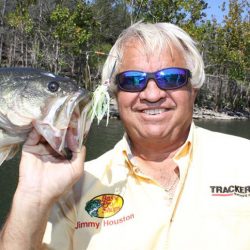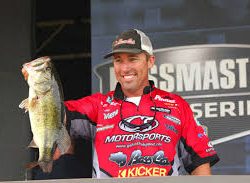Are The Best Fishing Tips & Trends From Pros?
By Paul Crawford
The influence professional anglers have on fishing tips and techniques is obvious. From apps to tackle shops, pros peddle their favorite brands, tools, lures and tips under the guise of helping weekend anglers catch more fish. Is this a good thing? Should we do what they do?
In Part 1 of this article, Paul Crawford covers why we should ignore the pros along with a few things we should do different. Follow up with Part 2 for non-tournament techniques long forgotten in the world of bass fishing
Ignore The Pros ~ Part One
Since joining the on-line community a few years ago, I’ve chatted, posted, and emailed a lot of bass fishermen about approaches and techniques. We’ve long heard B.A.S.S. trumpet the impact of their professional trail on weekend fishermen, but until you’ve talked to people all over the country, it’s hard to appreciate just how big of an impact that has been. Lures, patterns, presentations, equipment, all have been adopted throughout the country and even the world based almost solely on tournament success at the professional level. It has certainly been a great thing in uncounted ways and has definitely improved the level and success of bass fishermen everywhere.
But there has been a trap many, and perhaps all fishermen have fallen in, depending too much on what the pros have done, learning by example instead of working out the problem based on knowledge and theory. We unthinkingly buy the latest hot bait, work the latest rage for a pattern or technique, approach a lake based on how a pro approaches it, generally rely on memory rather than thinking.
The thing the vast majority of fishermen forget is, this isn’t how the pros do it! They don’t fish a tournament based on what is working for someone else. A pro relies on his own knowledge and intuition, and you only see the results of who guessed right this week. Sure, information is shared among the pros, and the wise professional would never overlook an approach that is beating his own.
But for the most part, they fish to their own personal strengths using what they think will work and relying on their own experience. And perhaps the most overlooked factor in our follow-the-leader world is, unless you are a touring pro, you will probably have better success doing something different that a pro.
It’s a different world the pros live in. They are experts in the craft, for sure, but have substantially different problems to worry about than you do. It’s a new and strange lake every week. Different conditions, different water, different pattern. And you never read about 10th place, so you’re always fishing for the win, a big gamble you normally loose in any sport. They also simply have a lot more time over a very short period to work out a pattern on a particular lake. If you took a week of vacation and fished every day, would you fish it the exact same way every time out?
And perhaps the thing we forget the most is, they don’t always catch fish. In fact, I dare say the average stringer for the average pro on the average day is less than your average club fisherman.
I remember the rather confused look on one of my hero’s faces a few years ago. Rick Clunn, one of the best fishermen ever to climb in a boat, was a favorite to win the Bass Masters Classic since they were hitting crank baits that year, one of Rick’s true strengths. The tournament was indeed won with near record weights coming on crank baits. Rick? Two fish for just over 3 pounds in 4 days of fishing. But would you want to put your money in against him for a tournament held this weekend on your home lake? And, of course, perhaps the biggest difference between a pro and a weekend fisherman, the pro is there is make a living, not necessarily to have fun.
So, if we’re not suppose to do what the pros do, what are we suppose to do different? Maybe nothing radically different, but we need to take advantage of the opportunities that a pro can’t.
 First is our approach to our home waters. Jimmy Houston wrote in his recent book that, “I never fish over 10′ deep. The 10% of the lake that’s shallow has half of the fish and I don’t have time to learn the whole lake.” What’s wrong with that statement? Basically, the last part. You do have time to learn the whole lake, and it’s well worth your time to do it.
First is our approach to our home waters. Jimmy Houston wrote in his recent book that, “I never fish over 10′ deep. The 10% of the lake that’s shallow has half of the fish and I don’t have time to learn the whole lake.” What’s wrong with that statement? Basically, the last part. You do have time to learn the whole lake, and it’s well worth your time to do it.
From knowledge of seasonal patterns, we know the fish don’t always prefer the shallows, moving deep in summer and winter. The fish that do stay shallow get a lot of pressure from other fishermen and are either caught and kept when they reach 3 or 4 pounds, or they grow wise and wary of any bait we throw at them. So, if you want to target the fish that has less pressure, tend to be bigger fish, and are less affected by weather or temporary conditions, it pays off to learn those deep haunts where the big fish live.
You don’t have to do so all of the time, or every time out. But on those days when the shallow fish don’t cooperate, why not burn a little gas, move way off shore, and see if you can find something interesting. A lot of great deep structure or cover is marked on maps. There are old road beds, farm ponds, bridges, even entire towns flooded by the reservoir in deep water just waiting for you to explore them. If the wind or waves means it’s not a good day, try next week or next month. It may take years to really get to know a lake and explore her secrets. A pro has only a few days to learn a lake. You live there, take advantage of the fact.
Along the same lines, pros tend to cover large areas of water and cherry pick the fish. The pro doesn’t have the time to locate those honey holes that normally have at least a few fish. The pro has to keep moving and searching, try 40 or 50 spots in some cases in a single day, (you haven’t lived until you spent the day in the back of the boat with a pro fishing a run and gun dock pattern.) Do the math. With running time, you’re talking around 3 – 5 minutes per hole. The fish had better bite quick to catch up with these guys. This may be great, (unless you’re buying the gas), as long as the fish are predictable and cooperate when you get there.
But you’ve got the time to find those reliable spots over time and concentrate on those. There may 50
similar points on your lake, but you have time to cull down to the 5 or 6 best ones that normally hold fish without hitting every point every day. This lets you stay in productive water longer, giving you a much better chance at boating fish. Any you can keep in mind the Fisherman’s Mantra, “Never Leave Biting Fish Looking for Other Fish.” To a run and gun pro, 2 or 3 minutes without a bite means move. If you know you’re in a good spot, then keep in mind that if you catch 1 legal fish every hour, you’ll be culling and have a good limit by the end of the day.
Following that train of thought, you’ll notice that other than Larry Nixon (another of my heroes), the Texas Rig plastic worm is an obsolete antique among the pros. The pros are fishing for big fish and need to cover water, so a Carolina Lizard is the preferred tool of the trade. You can see this trend in the local tackle stores. Where once half of the store was filled with plastic worms, now spinner baits, crank baits, and such have pushed them into one or two small aisles mixed in with just as many lizards, soft jerk baits, and craws. Yet, at one time, the estimates were as high as 90% of all fish were caught on plastic worms. What happened?
Well, even though there are a 1000 ways to effectively fish a plastic worm, they are all pretty slow presentations, extremely unsuited to run and gun styles. So, if the pros gave up on them, most of the locals did as well. But I’m here to tell you worms still work as well as ever and I can’t think of anything as reliable as the plastic worm under all conditions in all seasons. Again we’ve let our thoughts on what works for a pro on a strange lake overrule our own experience in well know waters.
The same can be said for any of the slow presentations. If you know you’re in a good spot, slow down and work it thoroughly with a known good bait instead of chasing fish that may or may not be there in less productive water. Think of how much fun catching fish on a slow top water can be. Why do we all think we’re Zell Roland and skitter a Pop-R or maybe a buzz bait across the top, and if that doesn’t work, give up on one of our favorite, and most productive baits?
Even slow rolling a spinner bait in deep water is being forgotten when it was all the rage only 5 years ago. I recently saw an article in a local paper giving advice from one of the touring pros. This pro said the only productive way of fishing a spinner bait was right under the surface and you had to be able to see the bait at all times to know when to set the hook. Bull Hockey! Over the last 10 years, many more fish have been caught on spinner baits by working them in 10′ -15′ of water over heavy cover right down on the bottom by pros and weekend fishermen alike.
Perhaps America’s Favorite Fisherman, Bill Dance (#1 on my list of heroes), has tried to teach us for years that spinner baits put out more vibration and are easier to work with a single blade than with a tandem. Another World Class spinner bait fisherman, Hank Parker, rarely uses anything under a ½ ounce bait in water over 3′ deep. But head to the tackle store and try to find a single blade bait or one ½ oz or better. Slow rolling baits take valuable tournament time and is unsuited for covering vast amounts of water quickly (I say that because that’s what’s preached, actually I cover the water pretty good with a ½ oz single willow leaf).
The poor weekend fisherman reads all of this stuff in the magazines and believes it, passing up what his own experience and the advice of other excellent fishermen tell him.

